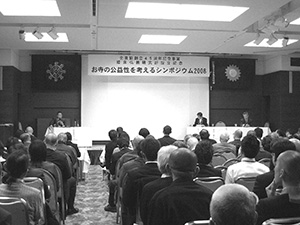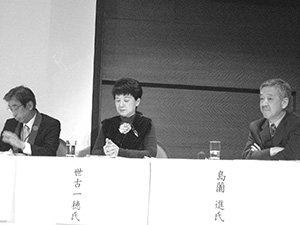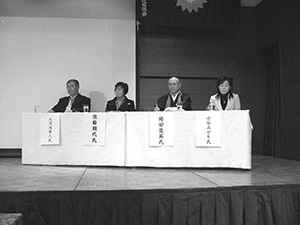Symposium Commemorating the 45th Anniversary of the Zenseikyo Foundation and
the Founding of the Rinbutsuken Institute for Socially Engaged Buddhism
Searching for the Possibility of the Buddhist Temple Linking to Society
1:30-5:30, March 7, 2008
Tokyo Grand Hotel
In 2007, the Zenseikyo Foundation & Buddhist Council for Youth and Child Edification greeted its 45th year of existence, and to commemorate this, we established on March 7th of 2008 the Rinbutsuken Institute for Socially Engaged Buddhism. The Institute’s main purpose is to widely disseminate opinions on the state of welfare and education aligned with the needs of Japanese society in this age of rapid change. This inaugural symposium entitled “Searching for the Possibility of the Buddhist Temple Linking to Society” was held in the Sakura-no-ma ballroom of the Tokyo Grand Hotel in Minato-ku, Tokyo. Participants from temple related people, common citizens, and the mass media totaled up to 200 to listen with deep interest about the role of temples and new possibilities for them in contemporary society.
Presentation of the Institute’s Activities and Study of the Perception of Temples
 Before beginning the symposium, Rev. Akitoshi Saito, the Secretary General of the Zenseikyo Foundation who was installed as the Chairman of the Rinbutsuken Institute, gave a greeting to the audience. This was followed by Rev. Hitoshi Jin, Director of Zenseikyo and Senior Fellow of the Institute, who gave a presentation on the Institute’s activities. Finally, Rev. Wakei Ishigami, an Associate Research Fellow at the Institute, gave a presentation on the 2007 study conducted on Zenseikyo members’ (predominantly priests and temple families) perception of the temple.
Before beginning the symposium, Rev. Akitoshi Saito, the Secretary General of the Zenseikyo Foundation who was installed as the Chairman of the Rinbutsuken Institute, gave a greeting to the audience. This was followed by Rev. Hitoshi Jin, Director of Zenseikyo and Senior Fellow of the Institute, who gave a presentation on the Institute’s activities. Finally, Rev. Wakei Ishigami, an Associate Research Fellow at the Institute, gave a presentation on the 2007 study conducted on Zenseikyo members’ (predominantly priests and temple families) perception of the temple.
In this survey, there were 341 responses and the average age of the respondent was 61 years old. According to the survey, 90% of respondents to the question, “Should temples be opened to the local community?” answered, “I think so.” To the question, “What are the activities you think are necessary for society?”, respondents mentioned that temples should be engaged in original Buddhist activities, like memorial services and propagation activities. However, they also mentioned activities like counseling common people who have anxieties, and running Sunday schools and education for the young. Further, there were results that showed that more than half of the respondents saw the need to grapple with the present problem of Japan’s aging society. Finally, specific comments by members who participated in the survey were introduced.
Concerning the question of whether to open up the temple or not, the opinion to promote the temple’s “public benefit character” (ko-eki-sei) was readily seen in such statements as: “I think temples which do not make a contribution to society will be forgotten”; “The people who visit temples do not consider whether it is near or far. They consider the abbot’s character. There are many people who want to know about Buddhism.”; and “If we open up the temple into the community, the people of the community will come to the temple to cooperate. The temple is a symbol of the community’s existence.”
On the other hand, there were guarded opinions like, “I don’t think the temple should be opened. The number of parishioners is high, so it’s takes all one’s energy to look after them.” Differences in will, intention, and opinion could be seen concerning the public activities of the temple, because of differences in the environment and various conditions of regions as well as the scale of the temple. It was natural for the research done by the institute to expect this situation.
Session 1: What is “Public Benefit Character” (ko-eki-sei)? Considering the Public Benefit Character of Temples
The symposium consisted of two parts. In the first part, three speakers were invited to participate in a panel discussion. They were Masahiro Hasegawa (a lawyer), Kazuho Seko (Professor at the Graduate School of Kanazawa University), and Susumu Shimazono (religious scholar and Professor at Tokyo University). Research Fellow Shinrei Suzuki acted as the coordinator for a 45 minute discussion.
Masahiro Hasegawa gave the first presentation on religion which has public benefit character. He gave an outline of the Japanese law on public benefit corporations (ko-eki-hojin), which was originally very vague but has been reformed and will now be put into effect. He said, “In the first place, the state should not have the power to interfere with whether a religious organization has public benefit character or not. However, from the standpoint of the temple and priest, there should surely be some self-realization and awareness of what extent the temple has public benefit character.” He pointed out that that temples will now have to come to grips with amendments to this public benefit corporations law.
The next speaker was Prof. Seko. While presenting a diagram of profit and non-profit organizations, she pointed out the problem of the temple inclining towards the side of the business sector, which seeks for profit, even thought originally it should be classified in the civil society NPO sector as a non-profit. Therefore, she said, “Unspecified large numbers of people come together to do things for unspecified large numbers of people, and that is, of course, public benefit character.
In this way, Prof. Seko offered the opinion that in order for temples to carry out public benefit activities for local communities, proper management is indispensible and that “temples which are designated as NPO temples” should do pro-active activities in order to develop greater self-awareness and greater adherence to the community
Furthermore, she had a proposal introducing “community restaurants”, which uses a business model of support the community by using food as a basis. Although there now does not exist such community restaurants which use temples, she asked the audience to examine the potential for temples to undertake this kind of initiative.
The next speaker, Prof. Shimazono who is an expert of religious studies, began his talk about acknowledging Prof. Seko’s comments and remarking that temples that act as community restaurants are one possibility which can be done as a public benefit activity. He then remarked that the temple’s basic value is above all “religiosity”, which should be foremost attained. Therefore, as “the basis of public benefit character is surely achieving the original role of the temple”, he emphasized that priests should not slacken in their efforts to seek the truth and be self-conscious of the duty of the temple.
Finally, Prof. Hasegawa again raised the point that, “There are many cases these days of the problem of harmonizing the benefit of the temple and the benefit of the abbot.” He urged the audience to be careful about the serious problem of whether existing temples are adhering to a form which protects private interests.
 A discussion session then followed with the 3 panelists responding in order to questions posed by the coordinator. To the question, “What is your frank opinion of the present situation of the traditional Buddhist denominations,” the panelists gave their thoughts from their own experiences and various specialist standpoints. Prof. Hasegawa made a particularly striking comment that, “Today’s temples deal with the funerals and memorial services that are part of the parishioner system (danka seido) like a manager deals with an apartment complex.” He explained that things like donations (dana/fuse) are expensive and that religion has taken on the role of a service industry. He also made a direct reference to the problem, which contemporary temples and therefore priests themselves bear, of temples making the effort make regular folk understand that dana is not about the price but is rather a religious practice. At the same time, there is a greater need for Buddhist priests and religious persons to resolve to become more habitually diligent.
A discussion session then followed with the 3 panelists responding in order to questions posed by the coordinator. To the question, “What is your frank opinion of the present situation of the traditional Buddhist denominations,” the panelists gave their thoughts from their own experiences and various specialist standpoints. Prof. Hasegawa made a particularly striking comment that, “Today’s temples deal with the funerals and memorial services that are part of the parishioner system (danka seido) like a manager deals with an apartment complex.” He explained that things like donations (dana/fuse) are expensive and that religion has taken on the role of a service industry. He also made a direct reference to the problem, which contemporary temples and therefore priests themselves bear, of temples making the effort make regular folk understand that dana is not about the price but is rather a religious practice. At the same time, there is a greater need for Buddhist priests and religious persons to resolve to become more habitually diligent.
Session 2: The Potential of Temples Being Connected to Society
In the second part of the symposium, there were presentations of the activities of Hidehito Okochi, Representative of the Komatsugawa Citizen’s Forum and Abbot of Juko-in Temple (Jodo Shu); Asayo Sato, Represenative of the NPO Keyano Forest and Nature School; and Toshihide Hakamata, Representative of the Thinking about Mind and Life Association and Abbot of Gesso-ji Temple (Soto Shu). As these three have perspectives as priests and as a temple wife, they have engaged in activities with a high level of public benefit for the local community.
The first presenter was Rev. Okochi, who while acting as the abbot of a temple in Edogawa ward in Tokyo, also provides access to a building he maintains for another temple to a collection of community NGOs called the Komatsugawa Citizen’s Forum.
At the same time, he is involved in international relief activities, human rights issues, and creating safe houses for abused children while acting as a representative Child Line. Finally, he is very active in environmental issues, attaching solar electric generating panels on his temple roof as part of creating a model case for conscientizing people at the community level about global environmental issues.
Rev. Okochi stated that, “While there are a variety of value systems, the real meaning of wealth is not just money or material things but opening up a future that points the way towards to an abundant lifestyle for all.” He further explained that, “I understand the various problems of connecting people to each other. There is a large basis for creating happiness for everyone. I want to offer the temple as a “locale” where there is a great potential for building the happiness of people in the community.”
The next speaker was Asayo Sato who gave a presentation on her activities as the Principal of the Keyano Forest School Kindergarten and Day Care Center, located in Saiyama City in Saitama Prefecture, and the Chairman of the Board of the NPO Keyano Forest Nature School. As the wife of a Buddhist priest, Sato established an unauthorized kindergarten about 30 years ago and since then has engaged in child education. She stresses experience in nature and what can be understood through the five senses through immersion in nature, such as simplicity, beauty, grandeur, and mystery.
 Furthermore, both children who have graduated the kindergarten and their parents have taken the opportunity to say that, “We would like more contact with nature and to be allowed to play in it.” Thus, Sato established the NPO “Keyano Forest School” in 1992. In this way, she has continuously undertaken a variety of rich programs held mostly on weekends to cultivate the power of life through experience in nature, such as camping and hiking by rivers, practicing meditation (zazen) and listening to talks by priests, as well as the experience of practicing like a novice priest. While introducing the audience to these activities through many photos of the children, she pointed out that, “Life is important, and being given the real feeling of living of course connects us to the power of life.”
Furthermore, both children who have graduated the kindergarten and their parents have taken the opportunity to say that, “We would like more contact with nature and to be allowed to play in it.” Thus, Sato established the NPO “Keyano Forest School” in 1992. In this way, she has continuously undertaken a variety of rich programs held mostly on weekends to cultivate the power of life through experience in nature, such as camping and hiking by rivers, practicing meditation (zazen) and listening to talks by priests, as well as the experience of practicing like a novice priest. While introducing the audience to these activities through many photos of the children, she pointed out that, “Life is important, and being given the real feeling of living of course connects us to the power of life.”
Finally, Rev. Hakamata gave a presentation on how he is grappling with the suicide problem in his area of Fujisato-cho in Akita prefecture. In order to cope with the particularly high rate among the elderly, he has helped to form the “Thinking about Mind and Life Association” in 2000. Rev. Hakamata talked about how Akita has the highest rate of suicide in Japan and the especially high rate of Fujisato-cho within Akita itself. One important cause that he raised has been the dissolution of human bonds, which previously existed from the core of community labor based agriculture in these rural towns, due to the mechanization of such agricultural work.
Therefore, he opened a cafe named “Yottetamore” to offer a place where people could feel comfortable to chat and where anyone could drop by. Further, he explained how they had through the “Thinking about Mind and Life Association” created a pamphlet on suicide prevention and had distributed it to the elderly in Fujisato-cho. Rev. Hakamata concluded by saying that, “In our present society which emphasizes efficiency, it has come to the point that most everyone pretends not to see others emotions and feelings such as anxiety, suffering, and sadness, because they are always seeking for convenience and ease. If we think in a Buddhist way, every single person has suffering, and there is the growth of humanity when we overcome it. The suicide problem is a symbol of suffering in today’s society, and in confronting this issue, I have myself come to a renewed understanding of Buddhism.”
What Temples and Priests can now do
In the discussion that was held afterwards, the coordinator Associate Researcher Midori Kotani said that, “While contemporary Japanese Buddhism has been referred to as “Funeral Buddhism”, there is an increase in the cases of funerals being conducted by people we would hardly call Buddhist priests.” Then she gave an outline of the problem of the contemporary circumstances around funerals and the temple.
After a lively debate, the main coordinator Rev. Jin said about the second part of the symposium that, “We have to introduce concretely the public benefit activities of temples in various different regions from the city to suburbs to country side.” He then concluded the symposium by saying, “It can be seen that in present day, temples tend to be withdrawn in on themselves, being connected only to a narrow world of temple families and parishioners. Originally, the temple had a history of being deeply rooted in the community, and it should increasingly by itself turn its attention to the existing community. Therefore, it’s important to look at the needs of the community and at the same time for priests themselves individually to understand their potential and direction. The groping towards a way for both the temple and community to find happiness is the first step towards temples with a high level of public benefit character based in Buddhist spirituality.”
There are currently 75,000 existing temples in the entire country that are dealing with very different situations and community styles. If the purpose of religion is to bring happiness to all people including family, friends, community members, and even oneself, there is the wish that this symposium has provided a foothold into the public benefit activities of the temple, the Buddhist world, and the religious world based on this concept of “engagement 臨床”

